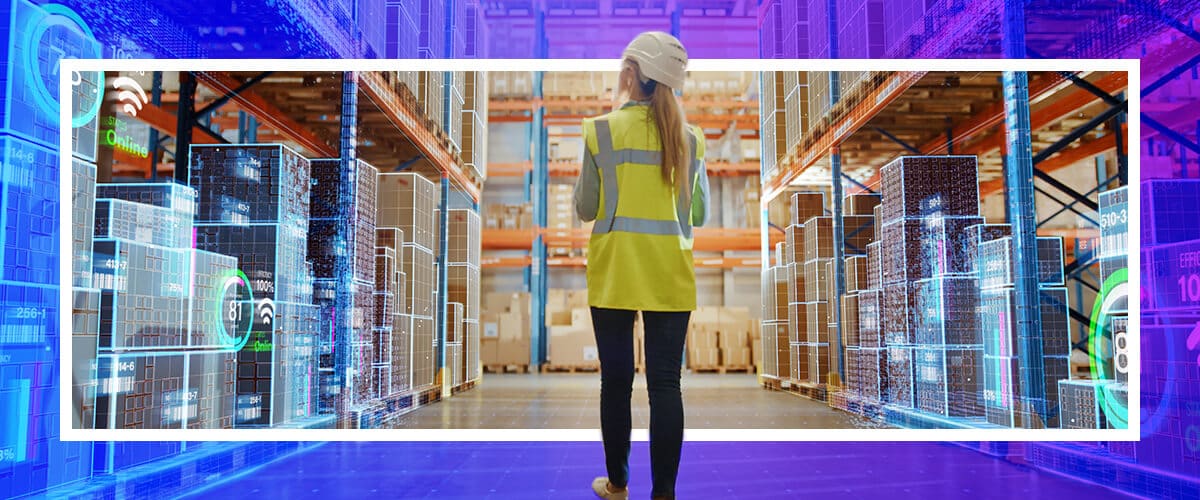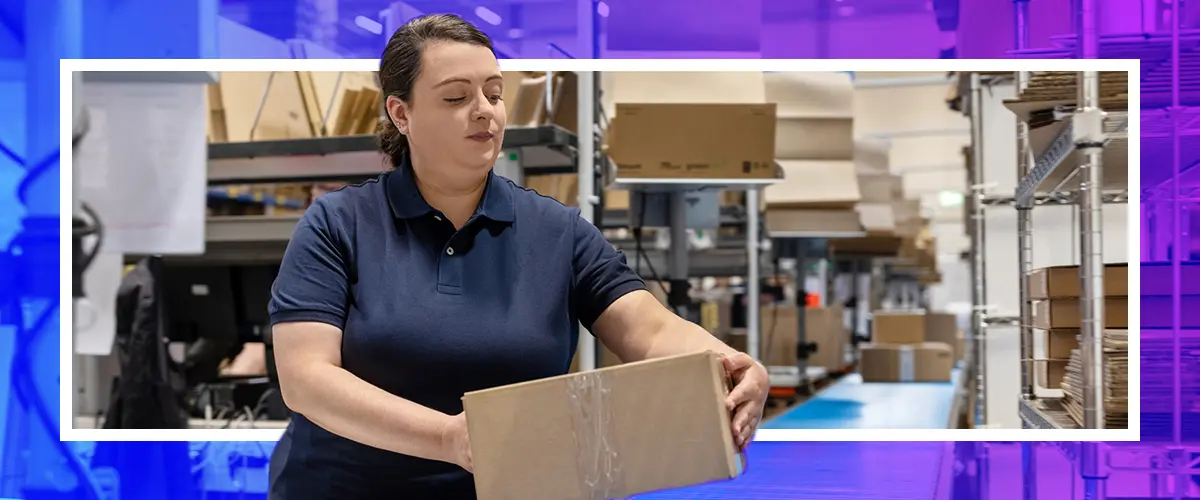Forget the futuristic talk; AI is on the warehouse floor, in your warehouse management system (WMS), and optimizing your logistics networks right now. It’s not just another tech trend; smart warehousing technology is reshaping fulfillment centers as it becomes a fundamental component for competitive advantage. Let’s explore how AI is delivering tangible productivity gains and what that means for your operations, backed by fresh insights from early 2025.
- The AI adoption curve: Are you keeping pace?
- AI’s quantifiable impact on productivity and costs
- Supercharging your operations: Speed, efficiency, and unprecedented accuracy
- Transforming your warehouse and beyond with AI
- Making AI work for your warehouse success
- What’s next in fulfillment AI?
- Embracing AI for a competitive future
- FAQs on improving warehouse productivity with AI
The AI adoption curve: Are you keeping pace?
The shift towards AI isn’t just happening; it’s accelerating. Consider this: 80% of online retailers are already leveraging AI in some capacity. This isn’t a tentative dip of the toe; it’s a strategic embrace.
For those of us in the logistics and fulfillment sector, the numbers are even more compelling. Within the logistics workforce, a significant 72% of employees are now utilizing AI tools. And the intensity of use? It has skyrocketed with a 250% increase in daily AI engagement among these professionals. This isn’t just about having the tools; it’s about them becoming integral to daily workflows.
The market is betting big on this transformation. The global AI in logistics and supply chain management market hit nearly $24.19 billion in 2024 and is on a trajectory to reach an eye-watering $134.26 billion by 2029. This level of investment underscores a clear industry consensus: AI is critical for future success and operational excellence. For decision-makers, this signals that AI is moving from a “nice-to-have” to a “must-integrate” to maintain a competitive edge.
AI’s quantifiable impact on productivity and costs
Let’s talk numbers that matter to your P&L. One of the most significant drivers for AI adoption is its proven ability to streamline operations and reduce costs. Industry analysis suggests AI has the potential to slash overall supply chain and logistics costs by an impressive 15% through intelligent process optimization.
This isn’t just theoretical. As of early 2025, 72% of retailers already using AI report that it’s actively helping them reduce operational costs. How? By optimizing resource allocation, minimizing waste, reducing errors, and driving greater efficiency across the board. For your high-volume operation, these percentages can translate into substantial savings.
Unlock a personalized tour of Logiwa IO
Supercharging your operations: Speed, efficiency, and unprecedented accuracy
AI’s benefits extend far beyond direct cost savings. It’s a powerhouse for making your fulfillment processes faster, more efficient, and significantly more accurate. The logistics sector, a frontrunner in AI adoption, now leads all industries in daily productive hours per employee, averaging 7 hours and 3 minutes, with a remarkable productivity efficiency rate of 96%. This performance is intrinsically linked to the deep integration of AI.
Consider the impact on traditionally labor-intensive tasks:
- Error Reduction: AI-based intelligent automation is significantly reducing manual effort and mitigating costly errors in critical areas like data entry, order processing, and invoice management. Fewer errors mean fewer costly exceptions, redos, and customer complaints.
- 24/7 Throughput: Inside the warehouse, AI-powered robots are enabling continuous, 24/7 operations. This means your facility can achieve maximum throughput, unconstrained by traditional shift patterns or break times.
- Inventory Optimization in Action: Look at major players like Walmart. They’ve accelerated their adoption of AI-driven analytics to fine-tune inventory management and sharpen demand forecasting. The result? Significant waste reduction and better product availability—a direct win for efficiency and customer satisfaction.
- Handling the Peaks with Poise: Seasonal surges or unexpected demand spikes can strain any operation. AI-driven Automated Storage and Retrieval Systems (AS/RS), like the Exotec Skypod system, can allow warehouses to seamlessly manage a 50% increase in order volume by dynamically scaling robot deployment. This adaptability is crucial for maintaining service levels without over-investing in fixed capacity.
Transforming your warehouse and beyond with AI
So, where is AI making the biggest difference in operations like yours?
- The AI-powered warehouse:
- Intelligent Robotics & AS/RS: AI is the conductor of the robotic orchestra. From precise picking and packing to intelligent sorting, AI guides robots to optimize every move. Advanced AS/RS leverage AI for dense storage and highly efficient goods-to-person workflows, often running non-stop.
Dynamic Slotting & Storage Optimization: Forget static warehouse layouts. With Logiwa IO’s Directed Putaway and Smart Picking features, AI algorithms continuously analyze order trends and inventory data to optimize item placement. High-velocity SKUs are directed closer to packing stations, slashing travel time and boosting picking efficiency.
- Next-Level Inventory Management:
- Predictive Demand Forecasting: AI excels at sifting through vast datasets—historical sales, market trends, promotions, even external factors—to generate incredibly accurate demand forecasts. This minimizes costly overstocking and frustrating stockouts. Leading retailers like Target and Unilever are actively using AI to bolster their forecasting capabilities.
- Smarter Logistics, From Dock to Doorstep:
- Optimized Route Planning: The last mile is a notorious cost center. AI algorithms crunch real-time data (traffic, weather, delivery windows) to calculate the most efficient routes, even making dynamic adjustments to preempt delays. This means lower fuel costs, better fleet utilization, and happier end customers.
Making AI work for your warehouse success
Implementing AI successfully isn’t just about buying software; it’s a strategic initiative. Key success factors include:
- Data is King (and Queen): The mantra “garbage in, garbage out” has never been more true. AI thrives on clean, well-structured, and actionable data. Investing in data governance and quality is non-negotiable.
- Bridging the Talent Gap: A lack of AI expertise is a significant hurdle for many. Cultivating in-house talent or forging strategic partnerships is crucial for effective deployment and ongoing optimization.
- Seamless Integration: AI solutions must talk to your existing WMS, ERP, and TMS platforms. Look for solutions, often SaaS-based, that facilitate this integration for end-to-end visibility and workflow continuity.
What’s next in fulfillment AI?
The AI landscape is ever-evolving:
- Generative AI (GenAI) enters the chat: Beyond analytics, GenAI (think ChatGPT for business) is poised for rapid adoption. Gartner predicts it will reach the “Plateau of Productivity” within two years. Imagine GenAI creating operational summaries, streamlining customer communications, or even assisting with complex logistics planning.
- Towards the “Self-Driving” Supply Chain: The concept of “Agentic AI” is emerging, where AI systems can make more autonomous decisions—selecting carriers, optimizing routes, and responding to disruptions with minimal human oversight.
Embracing AI for a competitive future
For decision-makers in high-volume fulfillment and 3PLs, AI is no longer on the horizon; it’s here, offering a powerful toolkit to enhance productivity, reduce costs, and build more resilient operations. The statistics from early 2025 paint a clear picture: widespread adoption, tangible cost savings, and significant boosts in operational efficiency are already being realized.
By strategically investing in AI, focusing on data quality, nurturing talent, and ensuring smart integration, you can unlock new levels of performance and position your operation for sustained success in an increasingly complex and competitive landscape.
The question isn’t if AI will transform fulfillment, but how quickly you can harness its power to your advantage. Schedule a demo of Logiwa IO today and let us show you why leading 3PLs and high-volume brands are choosing Logiwa to drive theirAI-powered warehouses.
FAQs on improving warehouse productivity with AI
How is AI currently transforming warehouse operations?
What are the quantifiable benefits of implementing AI in warehouse management?
What are the latest trends in AI for fulfillment and warehouse productivity in 2025?
- Predictive Demand Forecasting: AI algorithms analyze historical data, market trends, and even external factors like weather to create highly accurate demand forecasts, minimizing overstock and stockouts. This is a consistent theme in recent search data, emphasizing AI’s role in avoiding costly inventory issues.
- AI-Driven Route Optimization: AI is increasingly used to calculate the most efficient delivery routes by analyzing real-time data like traffic and weather, thereby reducing fuel costs and improving delivery times.
- Warehouse Automation & Robotics: The collaboration between humans and robots (cobots) is a growing trend, with AI guiding robots for tasks like picking, packing, and sorting, enhancing speed and accuracy. Automated Storage and Retrieval Systems (AS/RS) are becoming more sophisticated with AI.
- Generative AI (GenAI): Beyond analytics, GenAI is emerging for tasks like creating operational summaries, streamlining customer communications, and assisting in complex logistics planning. Gartner predicts GenAI will reach the “Plateau of Productivity” within two years.
- Agentic AI: This refers to AI systems that can make more autonomous decisions, such as selecting carriers and responding to disruptions with minimal human intervention, moving towards a “self-driving” supply chain.
Automated Data Integration and ETL: AI is simplifying the process of ingesting and transforming data, making it easier for non-technical users. - Natural Language Querying (NLQ): AI advancements allow users to query data warehouses using plain English, democratizing data access.
How can AI help in optimizing inventory management and demand forecasting?
What is "Directed Putaway" and "Smart Picking," and how does AI enable them?
- Directed Putaway: This feature uses AI to determine the optimal storage location for incoming items. Instead of static locations, AI directs items to spots that will minimize future travel time for picking, based on current demand and item velocity.
- Smart Picking: AI optimizes picking routes and directs warehouse staff or robots to the most efficient path to retrieve items for orders. High-velocity SKUs are often strategically placed closer to packing stations by AI-driven slotting, slashing travel time and boosting picking efficiency.
What are the key considerations for successfully implementing AI in a warehouse?
- Data Quality: AI thrives on clean, well-structured, and actionable data. Investing in data governance and ensuring data quality is crucial, as “garbage in, garbage out” is especially true for AI systems.
- Bridging the Talent Gap: A lack of AI expertise can be a significant hurdle. Companies need to either cultivate in-house talent or forge strategic partnerships to effectively deploy and optimize AI solutions.
- Seamless Integration: AI solutions must integrate smoothly with existing Warehouse Management Systems (WMS), Enterprise Resource Planning (ERP), and Transportation Management Systems (TMS) to ensure end-to-end visibility and workflow continuity. SaaS-based solutions often facilitate easier integration.
- Scalable Infrastructure: Investing in scalable, cloud-native platforms is recommended as they offer the flexibility and computing power needed for advanced analytics and machine learning.
- Focus on Data Governance: Implement strong data governance policies and automate data profiling to ensure consistent data standards.
What does the future hold for AI in fulfillment and warehouse operations?
- Generative AI (GenAI): Expected to become more prevalent for tasks like generating reports, automating customer communication, and even assisting in scenario planning for logistics.
- Agentic AI and “Self-Driving” Supply Chains: AI systems will likely become more autonomous, capable of making complex decisions like carrier selection, dynamic route optimization, and disruption response with minimal human input.
- Collaborative Robotics (Cobots): The trend of robots working alongside human employees will continue to grow, enhancing productivity and safety rather than fully replacing human workers.
- AI-Enhanced Data Governance and Quality: AI will play a larger role in ensuring data accuracy, compliance, and security.
- Multi-Agent AI Collaboration: Different AI systems specializing in various tasks (e.g., inventory, routing, customs) will learn to communicate and collaborate for more holistic operational adjustments.
By strategically adopting AI, focusing on data, talent, and integration, businesses can unlock significant productivity gains and maintain a competitive edge in the evolving logistics landscape.





